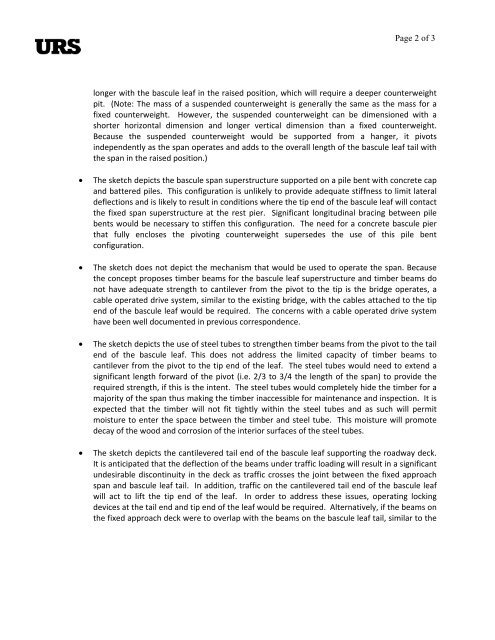March 1, 2012 Mr. Shoukry Elnahal, PE Deputy ... - Town to Chatham
March 1, 2012 Mr. Shoukry Elnahal, PE Deputy ... - Town to Chatham
March 1, 2012 Mr. Shoukry Elnahal, PE Deputy ... - Town to Chatham
Create successful ePaper yourself
Turn your PDF publications into a flip-book with our unique Google optimized e-Paper software.
Page 2 of 3<br />
longer with the bascule leaf in the raised position, which will require a deeper counterweight<br />
pit. (Note: The mass of a suspended counterweight is generally the same as the mass for a<br />
fixed counterweight. However, the suspended counterweight can be dimensioned with a<br />
shorter horizontal dimension and longer vertical dimension than a fixed counterweight.<br />
Because the suspended counterweight would be supported from a hanger, it pivots<br />
independently as the span operates and adds <strong>to</strong> the overall length of the bascule leaf tail with<br />
the span in the raised position.)<br />
<br />
<br />
<br />
<br />
The sketch depicts the bascule span superstructure supported on a pile bent with concrete cap<br />
and battered piles. This configuration is unlikely <strong>to</strong> provide adequate stiffness <strong>to</strong> limit lateral<br />
deflections and is likely <strong>to</strong> result in conditions where the tip end of the bascule leaf will contact<br />
the fixed span superstructure at the rest pier. Significant longitudinal bracing between pile<br />
bents would be necessary <strong>to</strong> stiffen this configuration. The need for a concrete bascule pier<br />
that fully encloses the pivoting counterweight supersedes the use of this pile bent<br />
configuration.<br />
The sketch does not depict the mechanism that would be used <strong>to</strong> operate the span. Because<br />
the concept proposes timber beams for the bascule leaf superstructure and timber beams do<br />
not have adequate strength <strong>to</strong> cantilever from the pivot <strong>to</strong> the tip is the bridge operates, a<br />
cable operated drive system, similar <strong>to</strong> the existing bridge, with the cables attached <strong>to</strong> the tip<br />
end of the bascule leaf would be required. The concerns with a cable operated drive system<br />
have been well documented in previous correspondence.<br />
The sketch depicts the use of steel tubes <strong>to</strong> strengthen timber beams from the pivot <strong>to</strong> the tail<br />
end of the bascule leaf. This does not address the limited capacity of timber beams <strong>to</strong><br />
cantilever from the pivot <strong>to</strong> the tip end of the leaf. The steel tubes would need <strong>to</strong> extend a<br />
significant length forward of the pivot (i.e. 2/3 <strong>to</strong> 3/4 the length of the span) <strong>to</strong> provide the<br />
required strength, if this is the intent. The steel tubes would completely hide the timber for a<br />
majority of the span thus making the timber inaccessible for maintenance and inspection. It is<br />
expected that the timber will not fit tightly within the steel tubes and as such will permit<br />
moisture <strong>to</strong> enter the space between the timber and steel tube. This moisture will promote<br />
decay of the wood and corrosion of the interior surfaces of the steel tubes.<br />
The sketch depicts the cantilevered tail end of the bascule leaf supporting the roadway deck.<br />
It is anticipated that the deflection of the beams under traffic loading will result in a significant<br />
undesirable discontinuity in the deck as traffic crosses the joint between the fixed approach<br />
span and bascule leaf tail. In addition, traffic on the cantilevered tail end of the bascule leaf<br />
will act <strong>to</strong> lift the tip end of the leaf. In order <strong>to</strong> address these issues, operating locking<br />
devices at the tail end and tip end of the leaf would be required. Alternatively, if the beams on<br />
the fixed approach deck were <strong>to</strong> overlap with the beams on the bascule leaf tail, similar <strong>to</strong> the
















